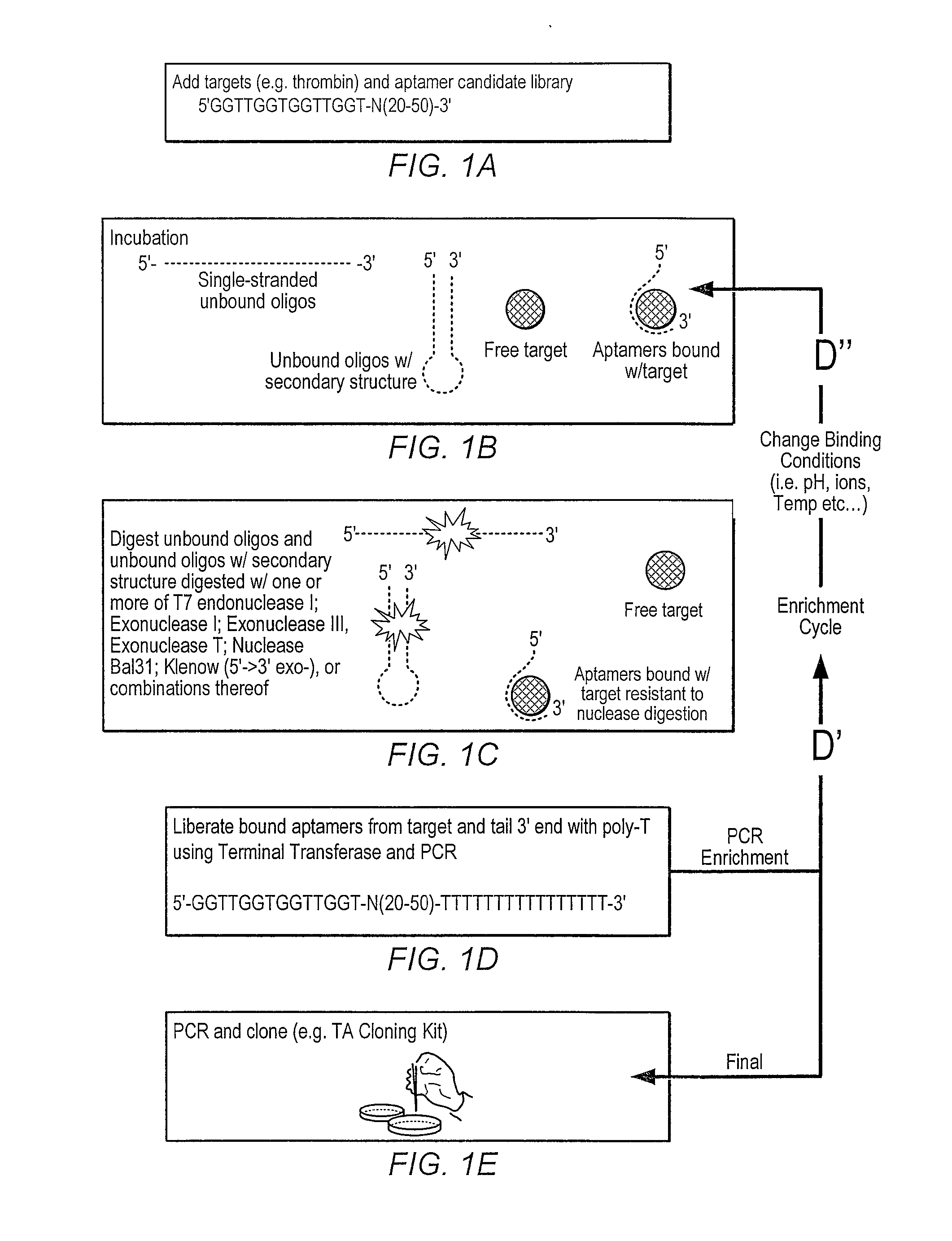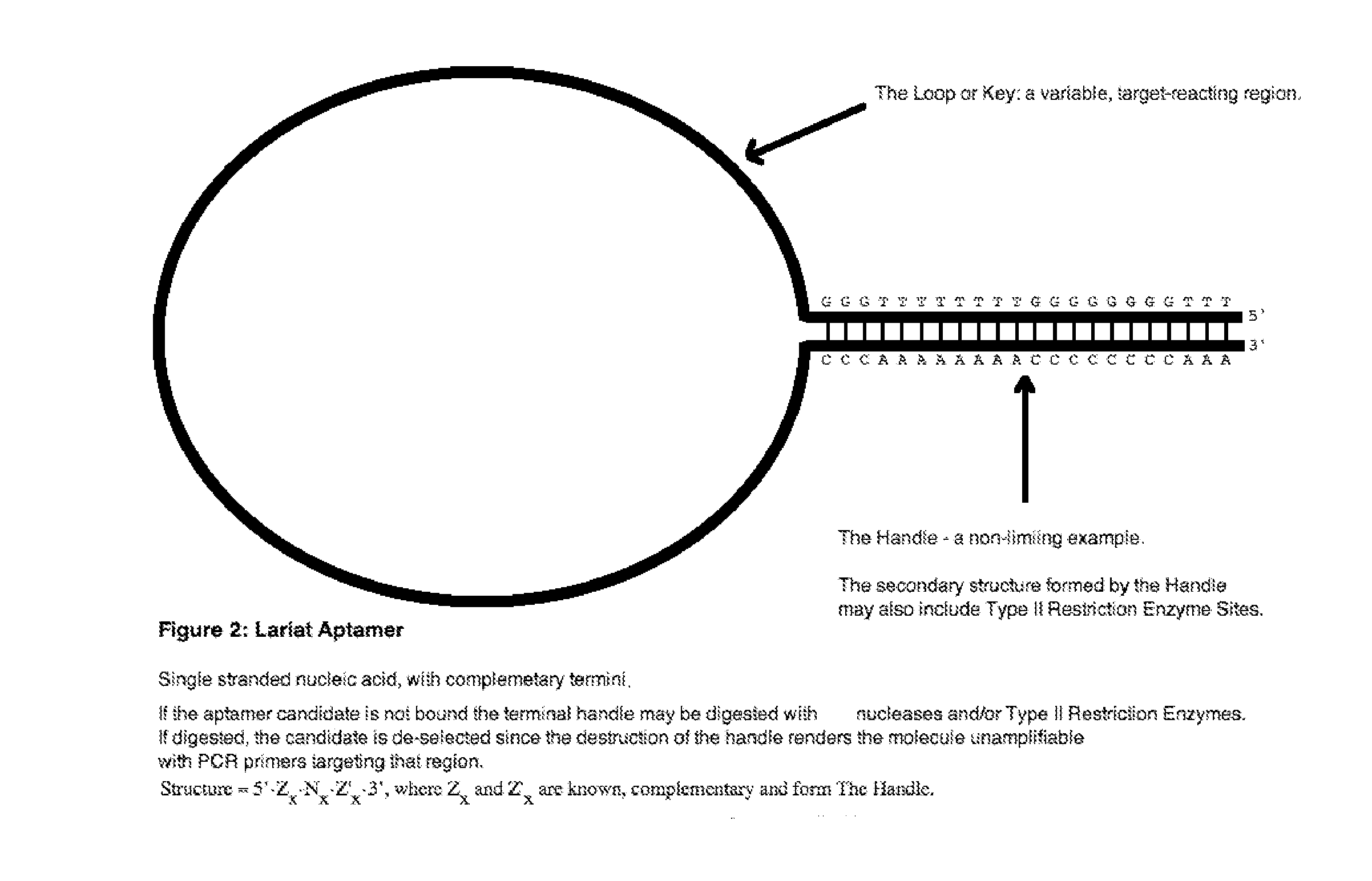lariat aptamer: aptamer candidate exclusion by nuclease digestion
a technology of aptamer and nuclease, applied in the field of molecular biology, can solve the problems of scalability and cost, severe limitations, and extremely difficult to elicit antibodies to aptamers
- Summary
- Abstract
- Description
- Claims
- Application Information
AI Technical Summary
Benefits of technology
Problems solved by technology
Method used
Image
Examples
example 1
[0076]One general example of the starting material for a nucleotide library is the sequence where Nx (which forms the Loop or Key) is A, G, C, T or, in the case of RNA, U, and where x is an integer from about 5 to about 100, or larger, where Z and Z′ is A, G, C, T or, in the case of RNA, U, and where x is an integer from about 5 to about 100, or larger, and where 4 and (which form the Handle) are complementary, or substantially complementary, to each other, thus forming secondary structure at the termini in physiological solution. One more specific example of the above form is the sequence 5′-TTTGGGGGGGGTTTTTTTTGGG-Nx-CCCAAAAAAAACCCCCCCCAAA-3′, where N is A, T, G, or C. where N is A, G, C, T or, in the case of RNA, U, where x is an integer from about 5 to about 100, or larger, where the sequence 5′-TTTGGGGGGGGTTTTTTTTGGG-3′ (SEQ ID NO:1) is an example of the 4 structure, and where the sequence 5′-CCCAAAAAAAACCCCCCCCAAA-3′ (SEQ ID NO:2) is an example of the Z′x structure (or vice ver...
example 2
[0077]Another specific example of the 5′-4-Nx—Z′x-3′ form is the sequence 5% TTTGGGGGGGATCCTTTTTGGG-Nx-CCCAAAAAGGATCCCCCCCAAA-3′, where N is A, T, G, or C. where N is A, G, C, T or, in the case of RNA, U, where x is an integer from about 5 to about 100, or larger, where the sequence 5′-TTTGGGGGGGATCCTTTTTGGG-3′ (SEQ ID NO:3) is an example of the 4 structure, and where the sequence 5′-CCCAAAAAGGATCCCCCCCAAA-3′ (SEQ ID NO:4) is an example of the Z′x structure (or vice versa), which includes a BamHI restriction enzyme site. This is a non-limiting example, as any type II restriction site might be employed to make the secondary structure vulnerable to digestive de-selection with restriction enzymes. This sequence is predicted to form secondary structure similar to that shown in FIG. 2. Those nucleotide library molecules that are not bound to their target are susceptible to nuclease digestion, for example by BamHI restriction enzyme and / or by Exonuclease III. Once digested, they are no lo...
example 3
[0078]Exonuclease I may, in some embodiments, be used to hydrolyze unbound oligos lacking secondary structure at the 3′ end (Lehman and Nussbaum, 1964; Goldmark and Linn, 1972; Rosamond et al., 1979). One Unit of Exonuclease I is defined as the amount of enzyme that will catalyze the release of 6×1015 bases in 30 minutes at 37° C. A first embodiment may begin with about 1.0 nmol of oligonucleotide library. The number of bases this represents can be calculated as follows: ((6×1023 molecules / mole)×(109 moles)×(100 bases / molecule))=6×1016 bases. 10 Units of Exonuclease I should completely hydrolyze the aptamer candidate library if they lacked secondary structure. This enzyme is available from New England Biolabs at 20 or 200 Units per μl.
[0079]Exonuclease III may, in some embodiments, may be used to hydrolyze unbound oligos having blunt, or recessed 3′ termini, including a stem loop, or handle (Xu and Evans, 2001; Parkinson and Lilley, 1997; White et al., 1997; Hadden et al., 2001). On...
PUM
| Property | Measurement | Unit |
|---|---|---|
| Temperature | aaaaa | aaaaa |
| Time | aaaaa | aaaaa |
| Molar density | aaaaa | aaaaa |
Abstract
Description
Claims
Application Information
 Login to View More
Login to View More - R&D
- Intellectual Property
- Life Sciences
- Materials
- Tech Scout
- Unparalleled Data Quality
- Higher Quality Content
- 60% Fewer Hallucinations
Browse by: Latest US Patents, China's latest patents, Technical Efficacy Thesaurus, Application Domain, Technology Topic, Popular Technical Reports.
© 2025 PatSnap. All rights reserved.Legal|Privacy policy|Modern Slavery Act Transparency Statement|Sitemap|About US| Contact US: help@patsnap.com



